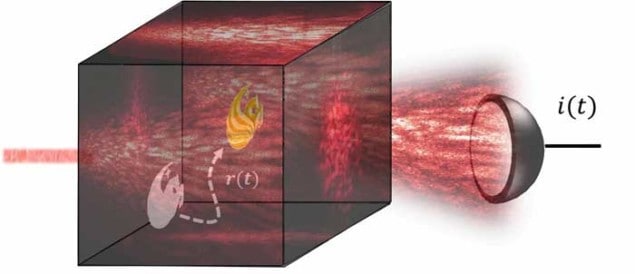
A simple, optical technique for tracking obscured or hidden objects has been developed by physicists in the US. The method uses randomized light signals to detect moving objects obscured by fog, cloud or other scattering media. The researchers say the technique could not only be useful for military and civilian surveillance, overcoming the limitations of radar and lidar, but also have biomedical applications.
Remote tracking of moving objects has many applications, including in military and civilian surveillance. Radar and lidar, for example, involve transmitting electromagnetic waves – radio or microwaves in the case of radar and ultraviolet, visible or near-infrared light for lidar – and then analysing the waves that bounce back from objects.
Despite being powerful tools, they require a direct line of sight between the object and the antenna, becoming much less effective when an object is obscured by conditions that scatter the waves, such as clouds, rain and fog. Although it is possible to track obscured objects by repeatedly imaging them, this requires complex equipment and data processing. As the scattering effect of any disturbances increases, the techniques can become so ineffective that they can even fail.
Part of the problem is that conventional methods for tracking hidden objects rely on regular wave pulses at a certain frequency, or combination of frequencies – deterministic signals. “If you have a signal that is regular, something that is deterministic, and you pass it through some disturbance it becomes corrupted – more or less depending on the strength of that disturbance,” explains team member Aristide Dogariu from the University of Central Florida.
Can’t break what’s broken
To tackle this difficulty, Dogariu and Milad Akhlaghi, also at the University of Central Florida, tried a different approach. In their latest research, published in Optica, they describe a technique that uses a random, or “noisy”, light signal to track a moving object surrounded by concealing scattering media. This works because although the noisy signal is corrupted when it is sent through the disturbance, its average properties are much more robust than those of a regular signal. “What is already destroyed cannot be destroyed further easily,” says Dogariu.
Dogariu and Akhlaghi developed statistical methods that allowed them to separate fluctuations in the frequency of the light emitted by the obscuring medium from those that are returned by the moving object. This only works, however, if the object and the obscuring medium are moving at different speeds, which means they each return a different spectral composition.
“You take the intensity variations of the light that comes out and then you construct a power spectrum of those fluctuations and you look in different frequency bands in that spectrum,” Dogariu explains. “This is done in real time as it does not require sophisticated calculations – it is just a power spectrum analysis.”
The researchers tested this idea by placing a small object in a plexiglass box covered with scattering layers of synthetic acrylics. They then shone a primary source of coherent light onto one of the scattering walls, creating a secondary light source inside the box. This light scattered off the target and was further randomized when it passed back through the acrylic walls, before being detected by a light detector in the form of a photomultiplier tube. By statistically analysing this signal, the researchers could track the full 3D trajectory of the object. This was effective for measurements of the signal taken from any location outside of the scattering box.
Hidden details
This technique cannot provide detailed information on the object being tracked, just its direction and speed of movement, as well as its rough size – based on the size of the signal it returns. As Dogariu explains, to know more about the object requires more expensive, sophisticated tests. “This is just a simple way of telling if [the target] starts moving and where it is going,” he adds.
The researchers now plan to test the technique in real-world, outdoor environments, adding that although they demonstrated a technique at optical frequencies, the method should work for other acoustic and microwave signals. They are also exploring possible biomedical applications.



